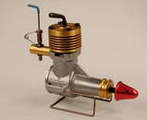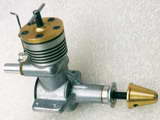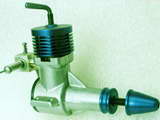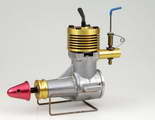Retro 2,5cc
 |
 |
 |
Click on images to view larger picture.
The Retro must have been one of the last 'modern' piston-port designs. They were made in Luxemburg between the mid 1970's and mid '90's by an expatriot French gentleman named André Demesse. André made a number of special engines in small numbers including a replica of the Allouchery 1,25 and some 5cc twins. No company was involved, they were just the personal production an individual who thought the name Retro sounded nice and suited the character of the engine. Sadly, he passed away in the late 1990's only 56 years of age.
This example in the picture comes from the Streigler Collection and has the serial number "013". Bert notes that the "O" is twice the size of the other digits. Bert loves surprising his friends and knowing that fellow Motor Boy David Owen had been unsuccessfully trying to locate a Retro for some time, sent it as a Christmas gift to David in 2008. Dave was delighted and pulled it apart to provide some technical information on its construction. Here is what he found:
I didn't take the prop driver off the spline for obvious reasons, but would guess that there is a small port leading to the bearing surface, at the end of the counterbore in the crankshaft. There are no hardened surfaces. The crankpin is quite worn.
The conrod ends have minimal material and the big end is badly worn, probably as a result of an unsuitable alloy. Better material may not have been readily available to the builder. The wrist pin appears to be drill rod and I would consider it undersize at 3mm.
The piston and cylinder are both steel and as Bert has noted, the compression seal is marginal. The contra-piston fit is too loose and while it may not leak, I'll bet Dallas to a pumpkin the compression screw runs back under vibration.
The cylinder is a very nice fit in the case and finned jacket. Porting is all over the place though, with some 35° "blowdown" between exhaust and transfer timing. There is no baffle on the piston. The inlet stub is far too high on the case and the builder has tried to rectify this error with a chamfered entry to the inlet port in the liner.
The screw holes drilled through the fins are far too large and allow the screws to float around. This is a pity, as indexing of the screw holes and the threaded holes in the case are both spot on.
 Lastly the NVA, which looks like a PAW unit but is definitely not, has no needle seat. In fact, the tip of the needle projects from the fuel nipple when fully closed. The novel tension arrangement utilising a scissor spring works very well. The small length of plastic tubing over the end of the needle, purpose unknown, is seen on all Retros. The gold and red anodising on this engine is very attractive. All Retros seen have similar anodising, with a whole range of colors.
Lastly the NVA, which looks like a PAW unit but is definitely not, has no needle seat. In fact, the tip of the needle projects from the fuel nipple when fully closed. The novel tension arrangement utilising a scissor spring works very well. The small length of plastic tubing over the end of the needle, purpose unknown, is seen on all Retros. The gold and red anodising on this engine is very attractive. All Retros seen have similar anodising, with a whole range of colors.
After all that criticism, what did I approve of and actually like? First, foremost, and above all, the engine is a refreshing attempt to produce a modern-looking piston-port engine. And I'd have to say that with the superb anodising, the clean, straightforward casting, and the balanced lines, this has been achieved even though the design itself is not modern in any way. That said, I don't think the designer really understood either the mechanical imperatives of design, nor the requirements of proper porting layout and timing (there is a later version with tangential ports which may have addressed these shortcomings). But I give him full marks anyway for producing an original engine design which has intrigued many of us. I am privileged to have the chance for a closer look at it than most! Many thanks to Bert for his generosity and to Brian Cox who supplied some of the background detail about André Demesse.